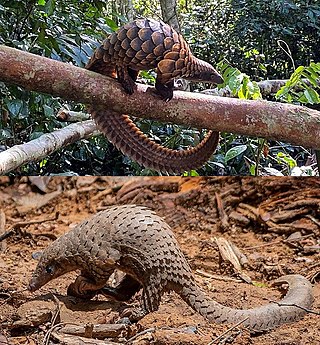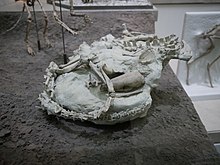
Manidae ("spirits") is the only extant family of pangolins from superfamily Manoidea. This family comprises three genera, as well as extinct Fayum pangolin.

Eomanis is the earliest known true pangolin from extinct family Eomanidae within suborder Eupholidota. It lived during the Eocene in Europe. Eomanis fossils found in the Messel Pit in Germany are very similar in size and anatomy to living pangolins of the genus Manis, indicating that pangolins have remained largely unchanged in morphology and behavior for 50 million years. However, unlike modern pangolins, its tail and legs did not bear scales. According to the stomach contents of the excellently preserved Messel specimens, Eomanis’ diet consisted of both insects and plants.

Metacheiromys is an extinct genus of placental mammals from extinct paraphyletic subfamily Metacheiromyinae within extinct paraphyletic family Metacheiromyidae in extinct order Palaeanodonta, that lived in North America from the early to middle Eocene.

Eurotamandua is an extinct genus of mammal from extinct family Eurotamanduidae that lived during the middle Eocene.

Necromanis is an extinct genus of pangolin from superfamily Manoidea. It lived from the middle Oligocene to middle Miocene in Europe. It was originally placed within family Manidae, but was eventually removed from it as more fossil pholidotids from outside that family were found and studied more extensively. Currently, Necromanis is placed as incertae sedis within the pholidotid superfamily Manoidea, together with the families Manidae and Patriomanidae.

Ernanodon is an extinct genus of placental mammal from extinct family Ernanodontidae within extinct order Palaeanodonta, that lived from the middle to late Paleocene in China and Mongolia.

Epoicotheriidae is an extinct paraphyletic family of insectivorous placental mammals within extinct order Palaeanodonta, that lived in North America, Asia and Europe from the late Paleocene to early Oligocene. Epoicotheriids were fossorial mammals. Late Eocene/early Oligocene genera were highly specialized animals that were convergent with the talpids, golden moles and marsupial mole in the structure of their skulls and forelimbs, and would have had a similar lifestyle as subterranean burrowers.
Escavadodon is an extinct genus of pangolin-like myrmecophagous placental mammals of extinct monotypic family Escavadodontidae within extinct order Palaeanodonta, that lived in North America during the middle Paleocene. It contains a single species, Escavadodon zygus, recovered from the Nacimiento Formation of New Mexico.

African tree pangolin (Phataginus) is a genus of African pangolins from subfamily small African pangolins (Phatagininae), within family Manidae. Its members are the more arboreal of the African pangolins.

African ground pangolin is a genus of pangolins from subfamily Smutsiinae within family Manidae. It was formerly considered a subgenus of genus Manis. Its members are the more terrestrial of the African pangolins. In past, this genus was also present in Europe.

Palaeanodonta is an extinct clade of stem-pangolins. They were insectivorous (myrmecophagous), possibly fossorial, and lived from the middle Paleocene to early Oligocene in North America, Europe and Asia. While the taxonomic grouping of Palaeanodonta has been debated, it is widely thought that they are a sister group to pangolins.

Patriomanidae is an extinct family of pangolins from superfamily Manoidea that includes two extinct genera Patriomanis and Cryptomanis.

Pholidotamorpha is a clade of placental mammals from mirorder Ferae that includes the order Pholidota and extinct order Palaeanodonta.

Euromanis is one of the earliest known pangolin genera. It lived during the middle Eocene in Europe. Euromanis fossils found in the Messel Pit in Germany. Unlike modern pangolins, it did not bear scales on its body.

Eupholidota is a suborder of pangolins that includes two superfamilies: extant Manoidea and extinct Eomanoidea.

Xenocranium is an extinct monotypic genus of placental mammal from extinct paraphyletic subfamily Epoicotheriinae within extinct paraphyletic family Epoicotheriidae in extinct order Palaeanodonta, that lived in North America during the late Eocene.
Smutsia olteniensis is an extinct species of pangolins from genus Smutsia of subfamily Smutsiinae within family Manidae. Fossilized remains of the species were found in Romania, providing evidence regarding the existence of pangolins in Europe during the Plio-Pleistocene period.

Metacheiromyidae is an extinct paraphyletic family of myrmecophagous placental mammals within extinct order Palaeanodonta, that lived in North America and Europe from the late Paleocene to middle Eocene.

Epoicotheriinae is an extinct paraphyletic subfamily of insectivorous placental mammals within extinct paraphyletic family Epoicotheriidae in extinct order Palaeanodonta, that lived in North America and Europe from the early Eocene to early Oligocene. Epoicotheriins were fossorial mammals. Late Eocene/early Oligocene genera were highly specialized animals that were convergent with the talpids, golden moles and marsupial mole in the structure of their skulls and forelimbs, and would have had a similar lifestyle as subterranean burrowers.
Cryptomanis is an extinct genus of pangolin from extinct family Patriomanidae. The genus is only known from the holotype specimen from middle Eocene deposits from Inner Mongolia, China. The holotype, AMNH 26140, was for years labeled as an unnamed pangolin in the fossil collection for decades. The remains comprise of an incomplete postcranial specimen, with nearly complete hind limbs, an incomplete pelvis, a complete lumbar series from an incomplete vertebral column, numerous fragmentary remains of rib and sternal bones, a fragmentary scapula, and partially preserved forelimbs. Based on the femural length Cryptomanis was comparable in size to the modern Sunda pangolin.















